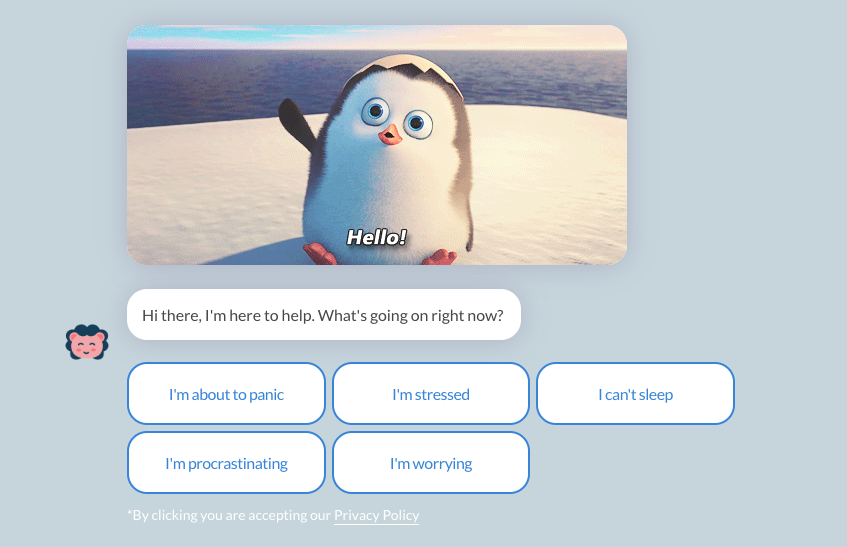Imagine for a moment you’re attending a dinner party. You don’t know the host, but you are meeting a mutual friend there. You arrive, the excitement is building as you get ready to meet new people and dine on delicious food. You reach out your hand and knock on the door. The door opens.
The host stands there staring at you. You expect them to take your coat. Or lead you to the dining room. Maybe engage in some small talk. Anything, really. But instead, you both stand there looking at each other in awkward silence.
Meanwhile, in an alternative universe, your host greets you warmly. They guide you towards the coat rack, inquiring about your journey. Perhaps they even show you where everything is to make you feel more at home. Or let you know when your mutual friend is scheduled to arrive.
If this interaction took place between your business chatbot and customer, which type of greeting would you want your chatbot to offer?
At a time when users’ attention is always shifting it’s more important than ever to pop up with messages that grab your target audiences virtually by their shoulders.
Chatbots: Your first impression online
The chatbot widget is a window of opportunity. In many cases, this is where your virtual visitors will interact with your brand for the first time. Whether it’s on social media or your company website, first impressions matter. Modify your chatbot greetings to match your audience, and you’ll be well on your way to connecting with the right prospects and improving your customer relationships.
But first, some do’s and don’ts before you write your compelling chatbot greetings:
- Stay on brand. Include your logo and decide if you want to be casual. This might include using friendlier language (e.g. “Hiya!” instead of “Hello”) or deciding to use emojis. Try to keep your messages conversational, and vary up your sentences to avoid sounding robotic.
- Avoid typos. No matter what your business — whether you’re a one-person consultancy or have several hundred employees — edit out those typos. They erode trust in your brand.
- Know your bot’s goal. What do you want people to do when they interact with your bot? Understanding this is key to creating effective chatbot greetings.
Tips to create compelling chatbot greetings
Know who your audience is
Chatbots come in all shapes and sizes and exist on multiple platforms (e.g. your website, and on social media). While diverse, they all serve similar functions: to automate answers to routine support and sales queries. They coordinate your first point-of-contact with a potential buyer or user and remove the burden of answering the same questions over and over again from your human team.
Who might the audience for a chatbot be? It depends on where your bot lives and which questions it will answer. Bots can even be broken down into public-facing or customer-facing types.
You may have multiple chatbots deployed across the following:
PlatformYour WebsiteFacebook MessengerHome PageTwitterPricing PageWhatsAppHelp Page
Determine where your bots are based and the unique messaging you’ll need to best serve your audiences. For example, on your pricing page, your message may speak directly to your pricing tiers or drive prospects straight to a sales call about your product or services.

Determine your call to action
Calls to actions are literally what they sound like - actions you want the visitor or customer to take. Depending on the department/industry your chatbot is for, this can vary widely.
For example, if you’re in sales, your chatbot CTAs could focus on driving demos with your sales teams. For marketing, you may want to pitch a webinar or signup for your newsletter. And for customer service, maybe you just want to make sure your customer has everything they need - and perhaps even upsell them on your services.
Here are a few more ideas for calls to action, depending on your use case:

Be personable and personalize your messages

Your bots are speaking to people - not to other bots. And no matter which industry you’re in, people like to be spoken to as people. The friendlier you make your chatbot, the more likely you are to make a good impression.
Chatbot providers offer hosts of integrations into tools that can help you automatically personalize your greetings. Integrations with tools like Clearbit, for example, helps you build a clearer picture of who your anonymous web visitors are. Use this information to your advantage in your messages - reach out with the right words to show you really know your audience.
Analyze and tweak your chatbot
Performance improvement is an integral part of work-life - and chatbots don’t take it personally when you retire them or give them a little bit of friendly advice. Many chatbots and live chat tools offer powerful analytics to help you track how many clicks and conversions your bot gets.

Another way to improve your chatbot greetings? Search through historic data for your most frequently asked questions and craft messages and responses based on those questions. Use analytics to measure your bot’s performance against the goals you set for it and don’t be afraid to tweak your chatbot greetings to try and improve your results.
Winning hearts and minds with words are not easy. Chatbots are a great way to deliver and hone your business pitch while being conversational.
Want to learn more about chatbots?
Get our complete guide to learn more about the nuts and bolts of chatbot technology, and how to implement successful chatbots.


